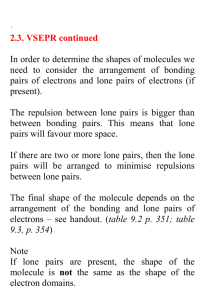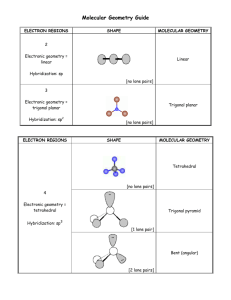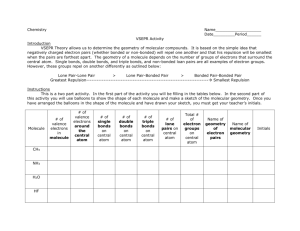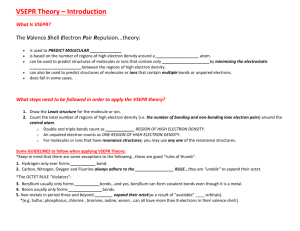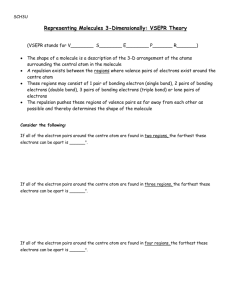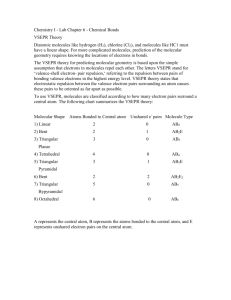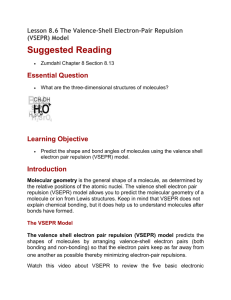Narration
advertisement
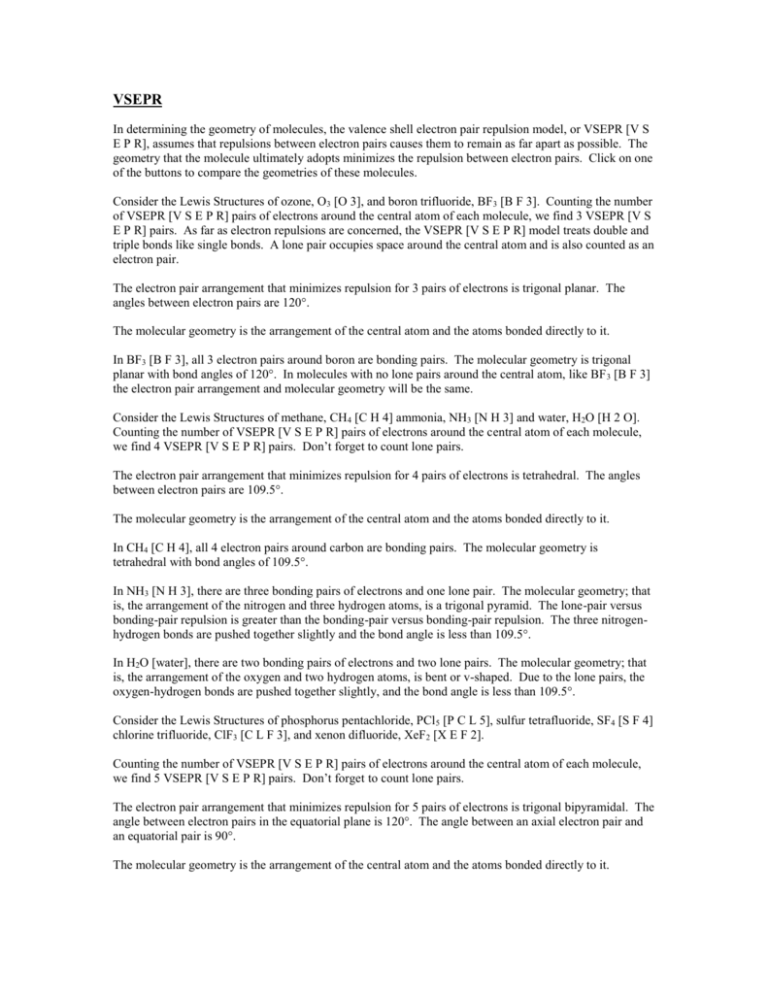
VSEPR In determining the geometry of molecules, the valence shell electron pair repulsion model, or VSEPR [V S E P R], assumes that repulsions between electron pairs causes them to remain as far apart as possible. The geometry that the molecule ultimately adopts minimizes the repulsion between electron pairs. Click on one of the buttons to compare the geometries of these molecules. Consider the Lewis Structures of ozone, O3 [O 3], and boron trifluoride, BF3 [B F 3]. Counting the number of VSEPR [V S E P R] pairs of electrons around the central atom of each molecule, we find 3 VSEPR [V S E P R] pairs. As far as electron repulsions are concerned, the VSEPR [V S E P R] model treats double and triple bonds like single bonds. A lone pair occupies space around the central atom and is also counted as an electron pair. The electron pair arrangement that minimizes repulsion for 3 pairs of electrons is trigonal planar. The angles between electron pairs are 120°. The molecular geometry is the arrangement of the central atom and the atoms bonded directly to it. In BF3 [B F 3], all 3 electron pairs around boron are bonding pairs. The molecular geometry is trigonal planar with bond angles of 120°. In molecules with no lone pairs around the central atom, like BF 3 [B F 3] the electron pair arrangement and molecular geometry will be the same. Consider the Lewis Structures of methane, CH4 [C H 4] ammonia, NH3 [N H 3] and water, H2O [H 2 O]. Counting the number of VSEPR [V S E P R] pairs of electrons around the central atom of each molecule, we find 4 VSEPR [V S E P R] pairs. Don’t forget to count lone pairs. The electron pair arrangement that minimizes repulsion for 4 pairs of electrons is tetrahedral. The angles between electron pairs are 109.5°. The molecular geometry is the arrangement of the central atom and the atoms bonded directly to it. In CH4 [C H 4], all 4 electron pairs around carbon are bonding pairs. The molecular geometry is tetrahedral with bond angles of 109.5°. In NH3 [N H 3], there are three bonding pairs of electrons and one lone pair. The molecular geometry; that is, the arrangement of the nitrogen and three hydrogen atoms, is a trigonal pyramid. The lone-pair versus bonding-pair repulsion is greater than the bonding-pair versus bonding-pair repulsion. The three nitrogenhydrogen bonds are pushed together slightly and the bond angle is less than 109.5°. In H2O [water], there are two bonding pairs of electrons and two lone pairs. The molecular geometry; that is, the arrangement of the oxygen and two hydrogen atoms, is bent or v-shaped. Due to the lone pairs, the oxygen-hydrogen bonds are pushed together slightly, and the bond angle is less than 109.5°. Consider the Lewis Structures of phosphorus pentachloride, PCl 5 [P C L 5], sulfur tetrafluoride, SF4 [S F 4] chlorine trifluoride, ClF3 [C L F 3], and xenon difluoride, XeF2 [X E F 2]. Counting the number of VSEPR [V S E P R] pairs of electrons around the central atom of each molecule, we find 5 VSEPR [V S E P R] pairs. Don’t forget to count lone pairs. The electron pair arrangement that minimizes repulsion for 5 pairs of electrons is trigonal bipyramidal. The angle between electron pairs in the equatorial plane is 120°. The angle between an axial electron pair and an equatorial pair is 90°. The molecular geometry is the arrangement of the central atom and the atoms bonded directly to it. In PCl5 [P C L 5] all 5 electron pairs around phosphorus are bonding pairs. The molecular geometry is trigonal bipyramidal with bond angles of 120° and 90°. In SF4 [S F 4], there are 4 bonding pairs of electrons and one lone pair. Lone pairs in a trigonal bipyramidal e- [electron] pair arrangement will occupy equatorial positions rather than axial positions. In SF4 [S F 4], if the lone pair is equatorial, there are two bonding pairs at 120° and two more at 90°. On the other hand, if the lone pair were in an axial position, there would be 3 bonding pairs at 90° and one pair at 180°. The repulsions are smaller if the lone pair is in the equatorial position. The molecular geometry; that is, the arrangement of the sulfur and four fluorine atoms, is a distorted tetrahedron or see-saw. Due to the lone pair, the sulfur-fluorine bonds are pushed together, and the bond angle in the equatorial plane is less than the typical 120° angle. In ClF3 [C L F 3], there are 3 bonding pairs of electrons and two lone pairs. The lone pairs occupy equatorial positions. The molecular geometry; that is, the arrangement of the chlorine and three fluorine atoms, is T-shaped. Due to the lone pairs, the chlorine-fluorine bonds are pushed together, and the F-Cl-F [fluorine, chlorine, fluorine] bond angles are slightly less than 90°. In XeF2 [X E F 2], there are 2 bonding pairs and three lone pairs. The lone pairs occupy the 3 equitorial positions. The molecular geometry; that is, the arrangement of the xenon and the two fluorine atoms, is linear. The F – Xe – F [fluorine, xenon, fluorine] bond angle is 180°. Consider the Lewis structures of sulfur hexafluoride, SF6 [S F 6], bromine pentafluoride, BrF5 [B R F 5] and xenontetrafluoride, XeF4 [X E F 4]. Counting the number of VSEPR [V S E P R] pairs of electrons around the central atom of each molecule, we find 6 VSEPR [V S E P R] pairs. Don’t forget to count lone pairs. The electron pair arrangement that minimizes repulsion for 6 pairs of electrons is octahedral. The angles between electron pairs are 90°. The molecular geometry is the arrangement of the central atom and the atoms bonded directly to it. In SF6 [S F 6], all 6 electron pairs around sulfur are bonding pairs. The molecular geometry is octahedral with bond angles of 90°. In BrF5 [B R F 5], there are 5 bonding pairs of electrons and one lone pair. All 6 octahedral positions are equivalent, so it does not matter where we place the lone pair. The molecular geometry; that is, the arrangement of the bromine and five fluorine atoms, is square pyramidal with bond angles of 90°. In XeF4 [X E F 4], there are 4 bonding pairs of electrons and two lone pairs. The lone pairs are arranged 180° to each other to minimize lone pair-lone pair repulsion. The molecular geometry; that is, the arrangement of the xenon and four fluorine atoms, is square planar with bond angles of 90°.
